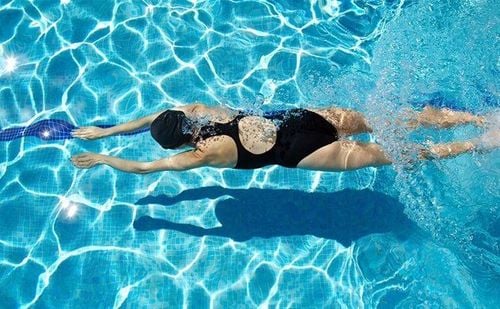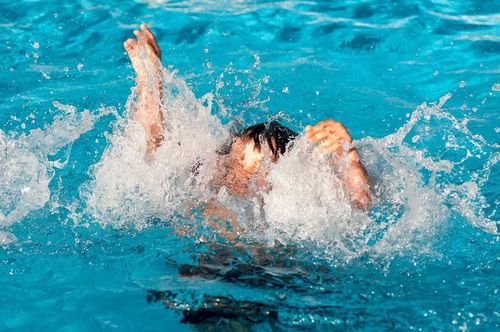This is an automatically translated article.
Swimming helps to lose weight, burn calories and reduce stress on the body. Swimming works all the major muscles and will help you tone and lose weight better! Whatever level you choose to swim at, swimming is good for you and it's never too late to learn or improve your swimming skills. A relaxing form of exercise that means weight loss with swimming is also fun! Read more to understand more about the benefits of swimming and weight loss.1. Weight loss effects and other benefits of swimming
Swimming is a sport for people of all ages because it is easy to practice and inexpensive. Swimming helps one get in shape and the benefits are also on mental health. A person may choose to swim over another form of exercise for a variety of reasons. Swimming provides the body with a complete workout and has many benefits for people of all ages and levels of swimming.Swimming burns calories thus helping you to lose weight and swimming for weight loss is frequently praised for its heart health benefits, especially for older adults. As swimming uses so many muscles in your body, your heart and lungs have to work hard to deliver oxygen to all of them. This means that swimming will give your cardiovascular system a great workout. As your heart and lungs get stronger, you'll be able to go longer before getting tired, your resting heart rate will drop, and your blood pressure will drop.
Swimming regularly when losing weight improves your health and can reduce your risk of chronic diseases, such as metabolic heart disease, type 2 diabetes and brain stroke.
Here are fifteen listed:
Swimming engages most of the major muscle groups, requiring a person to use their arms, legs, torso and abs.
1.1. Full body workout Swimming also:
Increases heart rate without stressing the body Improves strength Tones muscles Improves fitness Helps in weight control 1.2. Building cardiovascular strength Cardiovascular exercise, commonly known as cardio, involves the heart, lungs, and circulatory system. A well-rounded workout routine, such as one that features swimming, would include this type of exercise.
Research shows that swimmers have half the mortality rate of inactive people. A study from 2016 indicates that swimming can help lower blood pressure and control blood sugar.

Một thói quen tập luyện toàn diện, chẳng hạn như một thói quen có tính năng bơi lội, sẽ bao gồm loại bài tập tim mạch
1.4. A great skill to have The benefits of learning to swim safely and confidently can extend beyond the physical and mental. In some cases, swimming can save lives.
1.5. Good for the injured Having an injury or condition, such as arthritis, can make it difficult to exercise with high impact. Because the water gently supports the muscles, swimming is popular with many people who do not want to participate in high-impact exercises.
1.6. Good for people with disabilities Physical disabilities, such as hemiplegia, can limit exercise options. Because water provides resistance and support, many people find swimming an ideal choice. Because swimming can boost confidence and improve social skills, it may benefit people with mental disabilities.
1.7. Helps With Asthma In addition to building cardiovascular strength, swimming can increase lung capacity and improve breath control. While the humidified air of indoor pools can also help improve asthma symptoms, some studies indicate that the disinfectant chemicals used in pools can make symptoms worse. than. They can also increase the chances of swimmers developing the condition.
1.8. Improves Symptoms of Multiple Sclerosis (MS) Water keeps limbs afloat, so people with multiple sclerosis can benefit from the gentle support and resistance water offers. One study noted a significant reduction in pain when people with multiple sclerosis participated in a 20-week swimming program. Participants also reported improvements in fatigue and depression associated with multiple sclerosis.
1.9. Safety during pregnancy Swimming is a form of exercise that is recommended for pregnant women. Extra weight can cause joint and muscle pain during pregnancy. Swimming is especially popular among pregnant women as the water can support this weight. This helps you feel more comfortable when keeping in shape. Consult your doctor when undertaking a new form of activity during pregnancy.

Bơi lội là hình thức vận động được khuyến khích cho người mang thai
1.11. Variety and Fun People tend to get bored with repetitive exercises, but there are ways to make swimming fun. There are several strokes to master and buoyancy aids to try. Additionally, water aerobics and polo classes, as well as racing and diving, can help add variety.
1.12. Helps improve sleep A trial involving older adults with insomnia reported improved sleep in those who exercised regularly. A 2010 review determined that about half of the adult population has trouble sleeping. If accessible, swimming could be beneficial for those looking to sleep better.
1.13. Boosts Mood Exercise releases endorphins, which improve mood. Swimming can also boost confidence and social skills, which can impact a person's self-esteem. A 2014 pilot study involving people with dementia found that those who swam regularly over a 12-week period reported improved mood.
1.14. Managing stress Exercise is a great way to reduce stress and anxiety. It can also divert the mind from troublesome thoughts. Although more research is needed, even 20 minutes of physical activity per week can help a person feel more relaxed.

Tập thể dục là một cách tuyệt vời để giảm căng thẳng và lo âu
2. How does swimming help you lose weight?
Water is 800 times denser than air, which is why every push, kick, and pull is like a resistance exercise for the whole body. Swimming is great for your shoulders, arms, core, glutes, and hips. A comfortable swim burns about 500-600 calories in an hour while a strict regular swimmer can burn up to 700-800 calories. So when you swim, you not only burn calories, but also help build muscle. Which muscles boost your metabolism, help you burn more calories, and help you lose weight faster when swimming a lot.To lose weight, a person should swim based on their body weight, the strokes they use and their swimming speed. According to research in Disease Control and Prevention, people should swim for at least two hours and 30 minutes per week. Not only for weight loss, but swimming can also help you maintain your weight once you have lost the necessary amount of weight. 3,500 calories is equivalent to half a kilogram of weight.

Khi bơi, bạn không chỉ đốt cháy calo mà còn giúp hình thành cơ bắp
3. How to swim to lose weight
Whether you're swimming to lose belly fat, build lean muscle, or just change up your workouts, here's how to get the best results.3.1. Swim in the morning before eating Not everyone can swim in the morning but it is worth a try if you can get to the pool before work. Nick Rizzo, a trainer and fitness director at RunRepeat.com, a sneaker review website, explains: “Waking up in the morning and going for a swim puts your body in a fasted, ready state. willing to use those stored fats for energy. “Swimming is not only a good form of cardio but also a full body workout, so you can expect some great results.”
3.2. Swim harder and faster Swimming burns a lot of calories when you're just starting out. However, as your swimming skills improve and you become more efficient, your heart rate won't increase as much, warns Paul Johnson, founder of CompleteTri.com, a website that provides instructions , gear tips and reviews for swimmers, triathletes, and fitness enthusiasts. The solution, according to Johnson, is to swim harder and faster to keep your heart rate up.
Wear a waterproof fitness tracker to monitor your heart rate while swimming. Your target heart rate for moderate-intensity exercise should be about 50 to 70 percent of your maximum heart rate. You can calculate your maximum heart rate by subtracting your age from 220.
3.3. Take a swim class Learning proper stroke technique can help you swim at a moderate pace. Contact your community center or YMCA for information on swimming lessons, or sign up for a class through the American Red Cross.
3.4. Change your swimming routine If you swim at the same speed and repeat the same technique over and over, it may not be as effective. Stepping outside your comfort zone and varying your swimming routine is a great way to use different muscle groups, helping to maximize your weight loss results.

Nếu bạn bơi với cùng một tốc độ và lặp đi lặp lại cùng một kỹ thuật, có thể sẽ không hiệu quả cao
3.6. Start slow Start with 15 to 20 minutes of swimming every other day, then gradually increase to 30 minutes of swimming 5 days a week, depending on your fitness level. If you start a new swimming routine with too much intensity, sore muscles and fatigue can cause you to give up.
3.7. Alternating swimming with water aerobics You don't have to swim every day to see results. Take a water aerobics class on your days off. This is a great stress reliever to stay active during active recovery days.
3.8. Swim with a float If you're not a strong swimmer, swim laps in the pool using a pool bun, skateboard, or life jacket. These will help you stay afloat as you use your arms and legs to navigate the water.
3.9. Using water dumbbells If you're swimming to lose weight and tone, do a few biceps curls with water dumbbells in between rounds. Water creates drag, which can help build strength and endurance.
3.10. Adjust your diet With any weight loss program, you must burn more calories than you take in, and swimming is no exception. Therefore, to achieve effective weight loss you should adjust your diet
Hope the above information has provided you with more options and answers whether swimming can lose weight. Wish you always have a scientific diet and improve your work productivity and improve your life.
Please dial HOTLINE for more information or register for an appointment HERE. Download MyVinmec app to make appointments faster and to manage your bookings easily.
References: weightlossresources.co.uk, healthline.com, medicalnewstoday.com, ulusoyworkout.net












